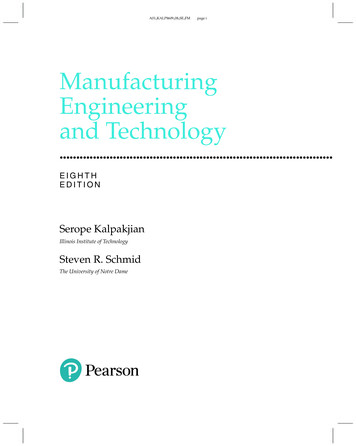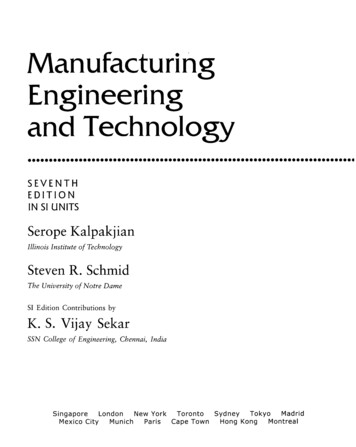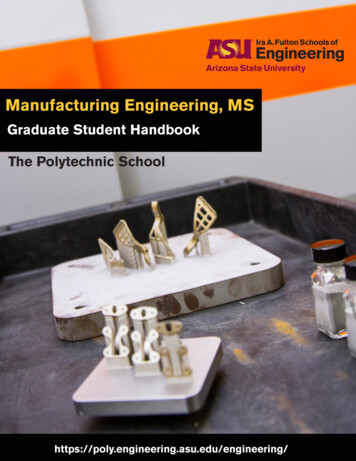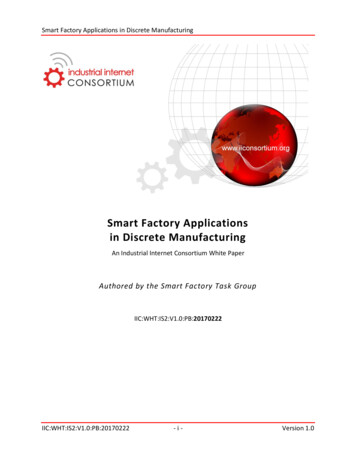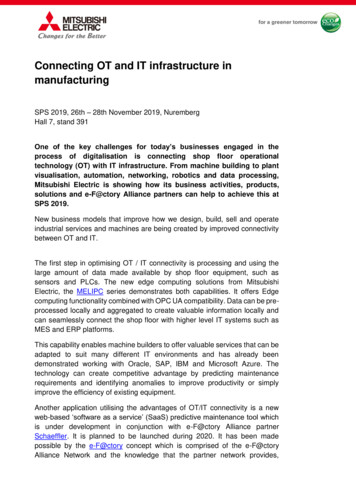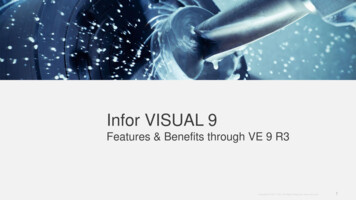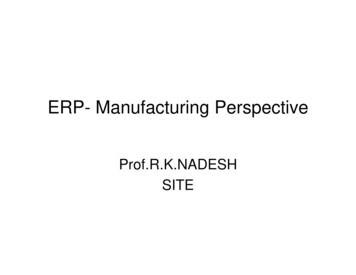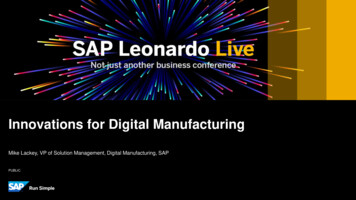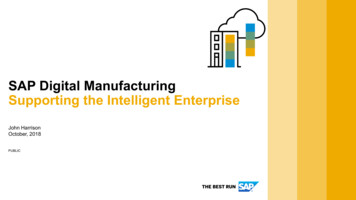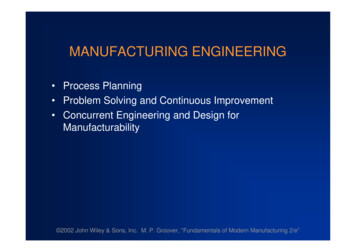
Transcription
MANUFACTURING ENGINEERING Process Planning Problem Solving and Continuous Improvement Concurrent Engineering and Design forManufacturability 2002 John Wiley & Sons, Inc. M. P. Groover, “Fundamentals of Modern Manufacturing 2/e”
Manufacturing Engineering DefinedTechnical staff function concerned with planning themanufacturing processes for the economicproduction of high quality products Principal role - to engineer the transition of theproduct from design specification to manufacture of aphysical product Overall goal - to optimize manufacturing within aparticular organization 2002 John Wiley & Sons, Inc. M. P. Groover, “Fundamentals of Modern Manufacturing 2/e”
Manufacturing Engineering Activities1. Process planning Deciding most appropriate processes and theirsequence Determining tooling requirements Selecting equipment Estimating costs2. Problem solving and continuous improvement - staffsupport to operating departments3. Design for manufacturability - serve asmanufacturability advisors to product designers 2002 John Wiley & Sons, Inc. M. P. Groover, “Fundamentals of Modern Manufacturing 2/e”
Process PlanningDetermining the most appropriate manufacturingprocesses and the sequence in which they should beperformed to produce a given part or productspecified by design engineering If an assembled product, deciding appropriatesequence of assembly steps Limitations imposed by available processingequipment and productive capacity of the factorymust be considered Parts or subassemblies that cannot be madeinternally must be purchased from external suppliers 2002 John Wiley & Sons, Inc. M. P. Groover, “Fundamentals of Modern Manufacturing 2/e”
Traditional Process Planning Traditionally, process planning is accomplished bymanufacturing engineers who are knowledgeable inthe particular processes used in the factory and areable to read engineering drawings Based on their knowledge, skill, and experience, theydevelop the processing steps in the most logicalsequence required to make each part Some details are often delegated to specialists, suchas tool designers; but manufacturing engineering isresponsible 2002 John Wiley & Sons, Inc. M. P. Groover, “Fundamentals of Modern Manufacturing 2/e”
Decisions and Details inProcess Planning Processes and sequence - the process plan shouldbriefly describe all processing steps used on the workunit in the order in which they are performed Equipment selection - try to develop process plansthat utilize existing plant equipment Otherwise, the part must be purchased, or newequipment must be installed in the plant Tools, dies, molds, fixtures, and gages - design isusually delegated to the tool design department, andfabrication is accomplished by the tool room 2002 John Wiley & Sons, Inc. M. P. Groover, “Fundamentals of Modern Manufacturing 2/e”
More Decisions and Details inProcess Planning Methods - include hand and body motions, workplacelayout, small tools, hoists for lifting heavy parts, etc. Methods must be specified for manual operations(e.g., assembly) and manual portions of machinecycles (e.g., loading and unloading a productionmachine) Estimating production costs - often accomplished bycost estimators with help from the process planner Cutting tools and cutting conditions for machiningoperations 2002 John Wiley & Sons, Inc. M. P. Groover, “Fundamentals of Modern Manufacturing 2/e”
Process Planning for Parts The processes needed to manufacture a given partare determined largely by the material out of whichthe part is made and the part design itself The material is selected by the product designerbased on functional requirements Once the material has been selected, the choiceof possible processes is narrowed considerably 2002 John Wiley & Sons, Inc. M. P. Groover, “Fundamentals of Modern Manufacturing 2/e”
Typical Processing Sequence A typical processing sequence to fabricate a discretepart consists of:1. A basic process2. One or more secondary processes3. Operations to enhance physical properties4. Finishing operations 2002 John Wiley & Sons, Inc. M. P. Groover, “Fundamentals of Modern Manufacturing 2/e”
Figure 41.2 - Typical sequence of processes required in part fabrication 2002 John Wiley & Sons, Inc. M. P. Groover, “Fundamentals of Modern Manufacturing 2/e”
Basic and Secondary Operations Basic process - establishes initial geometry ofworkpart Examples: metal casting, forging, sheet metalrolling In most cases, the starting geometry must bemodified or refined by a series of secondaryprocesses, which transform the basic shape into thefinal geometry Examples: machining, stamping 2002 John Wiley & Sons, Inc. M. P. Groover, “Fundamentals of Modern Manufacturing 2/e”
Operations to Enhance Propertiesand Finishing Operations Operations to enhance properties - heat treatmentoperations Treatments to strengthen metal components In many cases, parts do not require these propertyenhancing steps Finishing operations - the final operations in thesequence Usually provide a coating on the work surface Examples: electroplating, painting 2002 John Wiley & Sons, Inc. M. P. Groover, “Fundamentals of Modern Manufacturing 2/e”
Examples of Typical Process SequencesBasic ingoperationsSand castingMachiningHeat treatingPaintingRolling chining(none)PaintingExtrusion (Al)Cut to length(none)AnodizeCasting of glassPress, blowingAnnealingChem. etch 2002 John Wiley & Sons, Inc. M. P. Groover, “Fundamentals of Modern Manufacturing 2/e”
Process Planning and the Basic Process Process planning usually begins after the basicprocess has provided initial part shape Example: machined parts begin as bar stock orcastings or forgings, and the basic processes areoften external to the fabricating plant Example: stampings begin as sheet metal coils orstrips purchased from the mill These are the raw materials supplied from externalsuppliers for the secondary processes andsubsequent operations to be performed in the factory 2002 John Wiley & Sons, Inc. M. P. Groover, “Fundamentals of Modern Manufacturing 2/e”
The Route SheetThe document that specifies the details of the processplan The route sheet is to the process planner what theengineering drawing is to the product designer The route sheet should include all manufacturingoperations to be performed on the workpart, listed inthe order in which they are to be accomplished 2002 John Wiley & Sons, Inc. M. P. Groover, “Fundamentals of Modern Manufacturing 2/e”
Figure 41.3 –Typical route sheet for specifying the process plan 2002 John Wiley & Sons, Inc. M. P. Groover, “Fundamentals of Modern Manufacturing 2/e”
Process Planning for Assemblies For single stations, the documentation contains a listof the assembly steps in the order in which they mustbe accomplished For assembly line production, process planningconsists of line balancing - allocating work elementsto particular stations along the line As with process planning for individual parts, anytools and fixtures needed to accomplish a givenassembly task must be decided, and the workplacelayout must be designed 2002 John Wiley & Sons, Inc. M. P. Groover, “Fundamentals of Modern Manufacturing 2/e”
Make or Buy Decision Inevitably, the question arises whether a given partshould be purchased from an outside vendor or madeinternally It should be noted that virtually all manufacturerspurchase their starting materials from suppliers Very few production operations are verticallyintegrated all the way from raw materials tofinished product 2002 John Wiley & Sons, Inc. M. P. Groover, “Fundamentals of Modern Manufacturing 2/e”
Make or Buy Decision (continued) Given that a company purchases some of its startingmaterials, it is reasonable to question whether thecompany should purchase the parts that wouldotherwise be made in its own factory The answer to the question is the make or buydecision The make versus buy question is probablyappropriate to ask for every component used bythe company 2002 John Wiley & Sons, Inc. M. P. Groover, “Fundamentals of Modern Manufacturing 2/e”
Make or Buy ExampleThe quoted part price from a vendor 8.00 per unit for1000 units. The same part made in the home factorywould cost 9.00. The cost breakdown on the makealternative is as follows:Unit material cost 2.25 per unitDirect labor 2.00 per unitLabor overhead at 150% 3.00 per unitEquipment fixed cost 1.75 per unitTotal 9.00 per unitShould the component by bought or made in-house? 2002 John Wiley & Sons, Inc. M. P. Groover, “Fundamentals of Modern Manufacturing 2/e”
Make or Buy Example - continued Although the vendor's quote seems to favor the buydecision, consider the possible effect on the factory ifthe quote is accepted Equipment fixed cost is an allocated cost basedon an investment that has already been made If the equipment is rendered idle by a decision tobuy the part, then the fixed cost of 1.75 continueseven if the equipment is not in use The overhead cost of 3.00 consists of factoryfloor space, indirect labor, and other costs that willalso continue even if the part is bought 2002 John Wiley & Sons, Inc. M. P. Groover, “Fundamentals of Modern Manufacturing 2/e”
Make or Buy Example - continued By this reasoning, the decision to purchase mightcost the company as much as 8.00 1.75 3.00 12.75 per unit if it results in idle time in the factoryon the machine that would have been used to makethe part On the other hand, if the equipment can be used toproduce other components for which the internalprices are less than the corresponding externalquotes, then a buy decision makes good economicsense 2002 John Wiley & Sons, Inc. M. P. Groover, “Fundamentals of Modern Manufacturing 2/e”
Computer-Aided Process Planning (CAPP) During the last several decades, there has beenconsiderable interest in automating the processplanning function by computer systems Shop people knowledgeable in manufacturingprocesses are gradually retiring An alternative approach to process planning isneeded, and CAPP systems provide this alternative 2002 John Wiley & Sons, Inc. M. P. Groover, “Fundamentals of Modern Manufacturing 2/e”
CAPP Systems Computer-aided process planning systems aredesigned around either of two approaches:1. Retrieval systems2. Generative systems 2002 John Wiley & Sons, Inc. M. P. Groover, “Fundamentals of Modern Manufacturing 2/e”
Retrieval CAPP Systems Also known as variant CAPP systems Based on GT and parts classification and coding A standard process plan is stored in computer filesfor each part code number The standard plans are based on current partroutings in use in the factory, or on an ideal planprepared for each family For each new part, the standard plan is edited ifmodifications are needed 2002 John Wiley & Sons, Inc. M. P. Groover, “Fundamentals of Modern Manufacturing 2/e”
Figure 41.4 Operation of a retrieval type computer-aided processplanning system 2002 John Wiley & Sons, Inc. M. P. Groover, “Fundamentals of Modern Manufacturing 2/e”
Retrieval CAPP Systems - continued If the file does not contain a standard process planfor the given code number, the user may search thefile for a similar code number By editing the existing process plan, or startingfrom scratch, the user develops a new processplan, which becomes the standard plan for thenew part code Final step is the process plan formatter The formatter may call other application programs:determining cutting conditions, calculatingstandard times, or computing cost estimates 2002 John Wiley & Sons, Inc. M. P. Groover, “Fundamentals of Modern Manufacturing 2/e”
Generative CAPP Systems Rather than retrieving and editing existing plans froma data base, the process plan is created usingsystematic procedures that might be applied by ahuman planner In a fully generative CAPP system, the processsequence is planned without human assistance andwithout predefined standard plans Designing a generative CAPP system is a problem inexpert systems - computer programs capable ofsolving complex problems that normally require ahuman with years of education and experience 2002 John Wiley & Sons, Inc. M. P. Groover, “Fundamentals of Modern Manufacturing 2/e”
Components of an Expert system fora Generative CAPP System Knowledge base - the technical knowledge ofmanufacturing and logic used by process plannersmust be captured and coded in a computer program Computer-compatible part description - thedescription must contain all the pertinent data neededto plan the process sequence Inference engine - the algorithm that applies theplanning logic and process knowledge contained inthe knowledge base to a given part description 2002 John Wiley & Sons, Inc. M. P. Groover, “Fundamentals of Modern Manufacturing 2/e”
Benefits of CAPP Process rationalization and standardization –CAPPleads to more logical and consistent process plansthan when traditional process planning is used Increased productivity of process planners Reduced lead time to prepare process plans Improved legibility over manually written route sheets CAPP programs can be interfaced with otherapplication programs, such as cost estimating, workstandards, and others 2002 John Wiley & Sons, Inc. M. P. Groover, “Fundamentals of Modern Manufacturing 2/e”
Problem Solving Problems arise in manufacturing that requiretechnical staff support beyond what is normallyavailable in the line organization of the productiondepartments Providing this technical support is one of theresponsibilities of manufacturing engineering The problems are usually specific to the particulartechnologies of the processes performed in theoperating departments and engineering expertiseis often required to solve them 2002 John Wiley & Sons, Inc. M. P. Groover, “Fundamentals of Modern Manufacturing 2/e”
Con
Manufacturing Engineering Defined Technical staff function concerned with planning the manufacturing processes for the economic production of high quality products Principal role - to engineer the transition of the product from design specification to manufacture of a physical product Overall goal - to optimize manufacturing within a particular organization 2002 John Wiley & Sons, Inc .File Size: 451KBPage Count: 43


